2012 BMW 328I COUPE low beam
[x] Cancel search: low beamPage 111 of 314
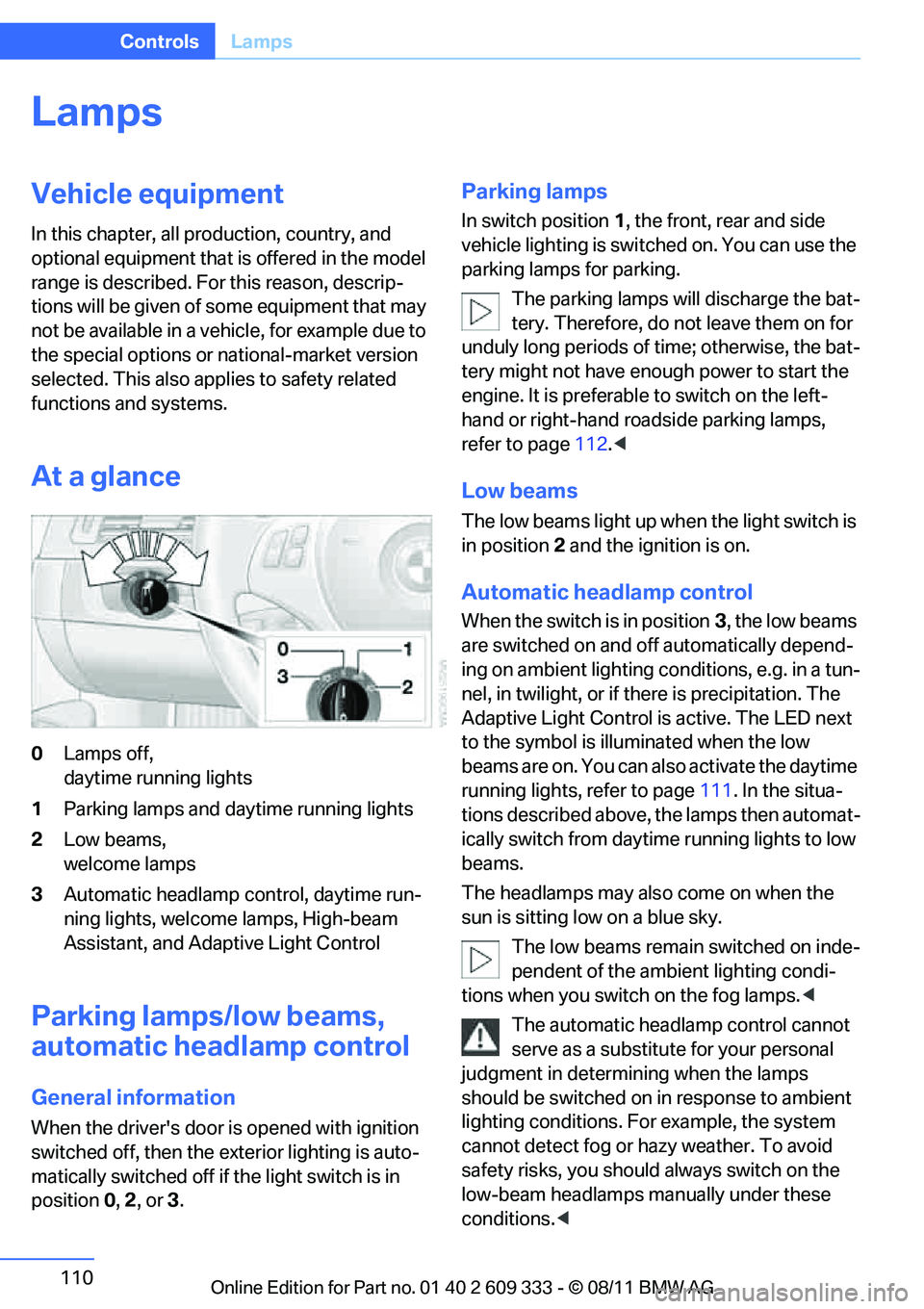
110
ControlsLamps
Lamps
Vehicle equipment
In this chapter, all pr oduction, country, and
optional equipment that is offered in the model
range is described. For this reason, descrip-
tions will be given of some equipment that may
not be available in a vehi cle, for example due to
the special options or national-market version
selected. This also app lies to safety related
functions and systems.
At a glance
0 Lamps off,
daytime running lights
1 Parking lamps and daytime running lights
2 Low beams,
welcome lamps
3 Automatic headlamp control, daytime run-
ning lights, welcome lamps, High-beam
Assistant, and Adaptive Light Control
Parking lamps/low beams,
automatic headlamp control
General information
When the driver's door is opened with ignition
switched off, then the exterior lighting is auto-
matically switched off if the light switch is in
position 0, 2 , or 3.
Parking lamps
In switch position 1, the front, rear and side
vehicle lighting is switch ed on. You can use the
parking lamps for parking.
The parking lamps will discharge the bat-
tery. Therefore, do not leave them on for
unduly long periods of time; otherwise, the bat-
tery might not have enou gh power to start the
engine. It is preferable to switch on the left-
hand or right-hand roadside parking lamps,
refer to page 112.<
Low beams
The low beams light up wh en the light switch is
in position 2 and the ignition is on.
Automatic headlamp control
When the switch is in position 3, the low beams
are switched on and off automatically depend-
ing on ambient lighting conditions, e.g. in a tun-
nel, in twilight, or if there is precipitation. The
Adaptive Light Control is active. The LED next
to the symbol is illu minated when the low
beams are on. You can also activate the daytime
running lights, refer to page 111. In the situa-
tions described above, the lamps then automat-
ically switch from daytime running lights to low
beams.
The headlamps may also come on when the
sun is sitting low on a blue sky.
The low beams remain switched on inde-
pendent of the ambient lighting condi-
tions when you switch on the fog lamps. <
The automatic headlamp control cannot
serve as a substitute for your personal
judgment in determining when the lamps
should be switched on in response to ambient
lighting conditions. For example, the system
cannot detect fog or ha zy weather. To avoid
safety risks, you should always switch on the
low-beam headlamps ma nually under these
conditions. <
Online Edition for Part no. 01 40 2 609 333 - \251 08/11 BMW AG
Page 112 of 314
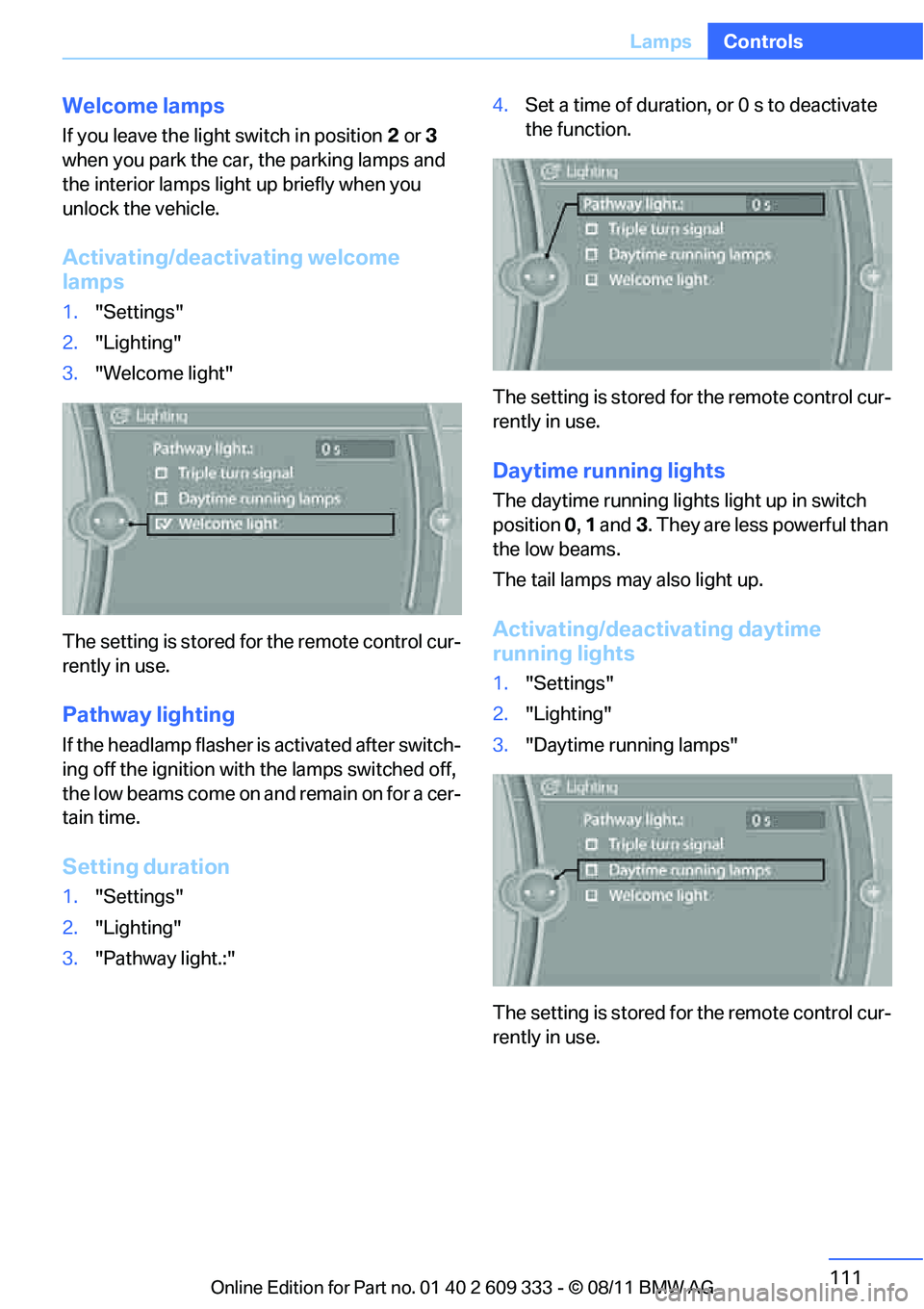
111
Lamps
Controls
Welcome lamps
If you leave the light switch in position
2 or 3
when you park the car, the parking lamps and
the interior lamps light up briefly when you
unlock the vehicle.
Activating/deactivating welcome
lamps
1. "Settings"
2. "Lighting"
3. "Welcome light"
The setting is stored for the remote control cur-
rently in use.
Pathway lighting
If the headlamp flasher is activated after switch-
ing off the ignition with the lamps switched off,
the low beams come on and remain on for a cer-
tain time.
Setting duration
1. "Settings"
2. "Lighting"
3. "Pathway light.:" 4.
Set a time of duration, or 0 s to deactivate
the function.
The setting is stored for the remote control cur-
rently in use.
Daytime running lights
The daytime running light s light up in switch
position 0, 1 and 3. They are less powerful than
the low beams.
The tail lamps may also light up.
Activating/deactivating daytime
running lights
1. "Settings"
2. "Lighting"
3. "Daytime running lamps"
The setting is stored for the remote control cur-
rently in use.
Online Edition for Part no. 01 40 2 609 333 - \251 08/11 BMW AG
Page 113 of 314
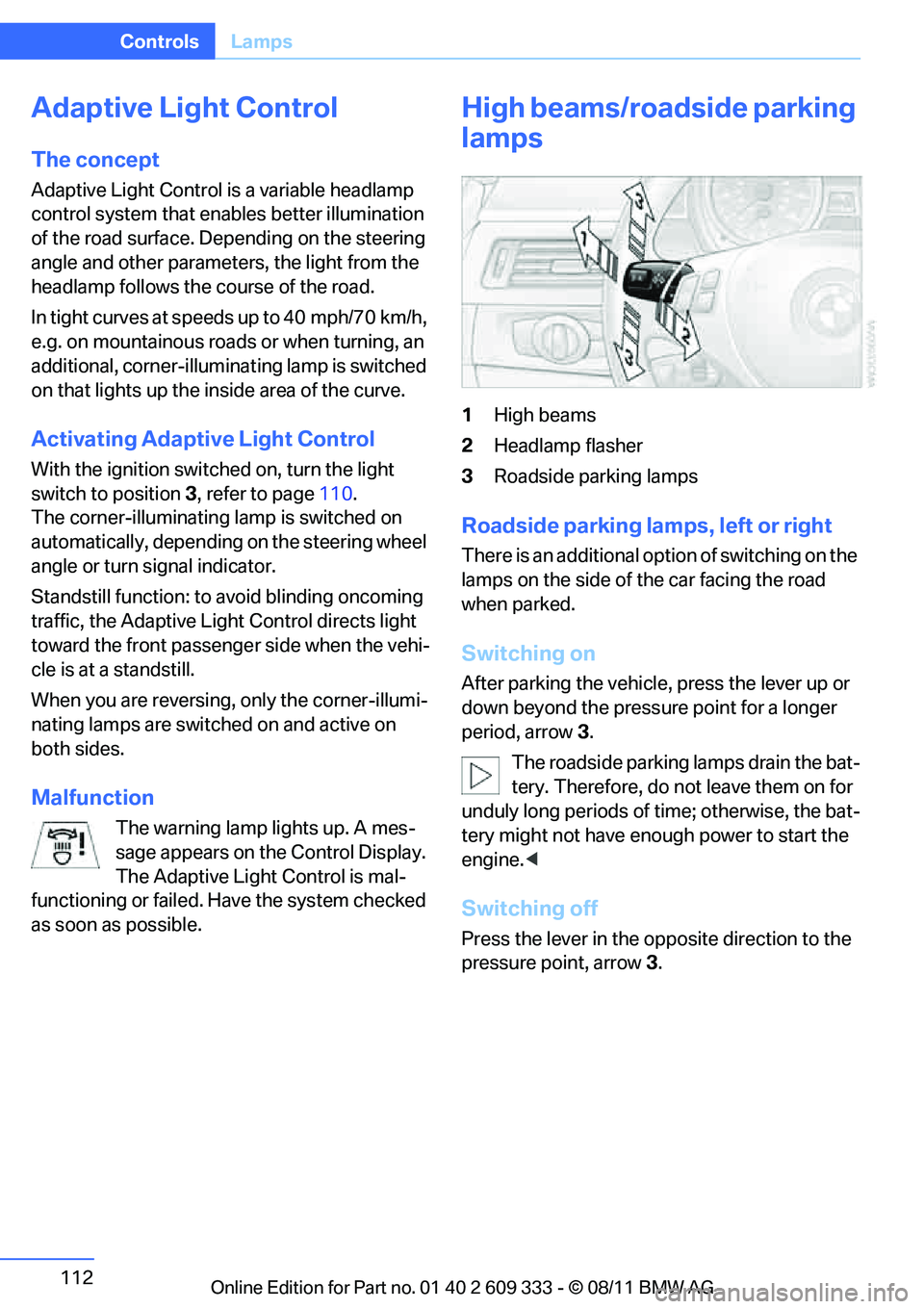
112
ControlsLamps
Adaptive Light Control
The concept
Adaptive Light Control is a variable headlamp
control system that en ables better illumination
of the road surface. Depending on the steering
angle and other parameters, the light from the
headlamp follows the course of the road.
I n t i g h t c u r v e s a t s p e e d s u p t o 4 0 m p h / 7 0 k m / h ,
e.g. on mountainous roads or when turning, an
additional, corner-illumina ting lamp is switched
on that lights up the inside area of the curve.
Activating Adaptive Light Control
With the ignition switched on, turn the light
switch to position 3, refer to page 110.
The corner-illuminating lamp is switched on
automatically, depending on the steering wheel
angle or turn signal indicator.
Standstill function: to avoid blinding oncoming
traffic, the Adaptive Light Control directs light
toward the front passenge r side when the vehi-
cle is at a standstill.
When you are reversing, only the corner-illumi-
nating lamps are switched on and active on
both sides.
Malfunction
The warning lamp lights up. A mes-
sage appears on the Control Display.
The Adaptive Light Control is mal-
functioning or failed. Ha ve the system checked
as soon as possible.
High beams/roadside parking
lamps
1 High beams
2 Headlamp flasher
3 Roadside parking lamps
Roadside parking lamps, left or right
There is an additional option of switching on the
lamps on the side of the car facing the road
when parked.
Switching on
After parking the vehicle, press the lever up or
down beyond the pressu re point for a longer
period, arrow 3.
The roadside parking lamps drain the bat-
tery. Therefore, do not leave them on for
unduly long periods of time; otherwise, the bat-
tery might not have enou gh power to start the
engine. <
Switching off
Press the lever in the o pposite direction to the
pressure point, arrow 3.
Online Edition for Part no. 01 40 2 609 333 - \251 08/11 BMW AG
Page 114 of 314
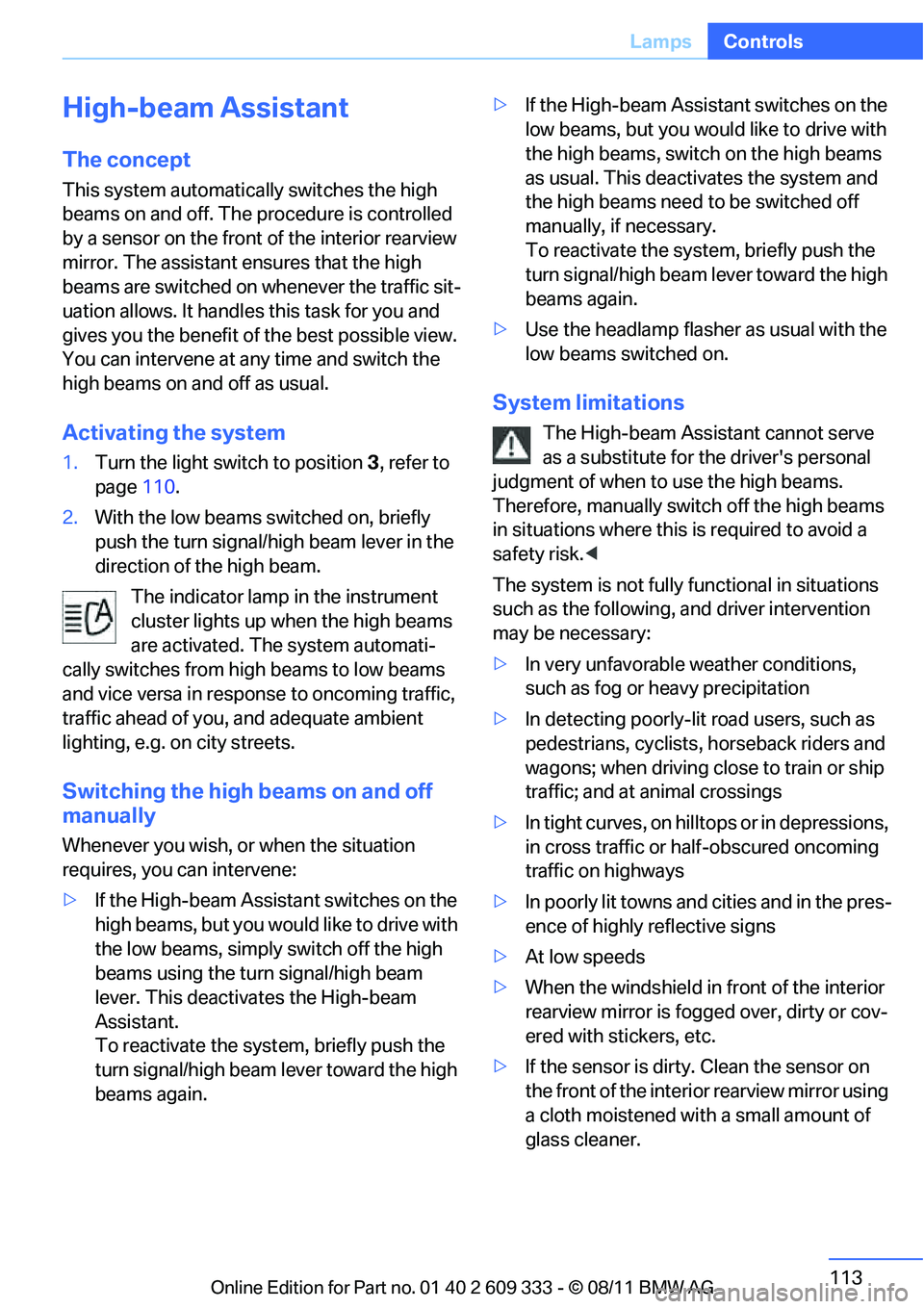
113
Lamps
Controls
High-beam Assistant
The concept
This system automatica
lly switches the high
beams on and off. The procedure is controlled
by a sensor on the front of the interior rearview
mirror. The assistant ensures that the high
beams are switched on whenever the traffic sit-
uation allows. It handle s this task for you and
gives you the benefit of the best possible view.
You can intervene at any time and switch the
high beams on and off as usual.
Activating the system
1. Turn the light switch to position 3, refer to
page 110.
2. With the low beams switched on, briefly
push the turn signal/high beam lever in the
direction of the high beam.
The indicator lamp in the instrument
cluster lights up when the high beams
are activated. The system automati-
cally switches from hi gh beams to low beams
and vice versa in response to oncoming traffic,
traffic ahead of you, and adequate ambient
lighting, e.g. on city streets.
Switching the high beams on and off
manually
Whenever you wish, or when the situation
requires, you can intervene:
> If the High-beam Assistant switches on the
high beams, but you would like to drive with
the low beams, simply switch off the high
beams using the turn signal/high beam
lever. This deacti vates the High-beam
Assistant.
To reactivate the syst em, briefly push the
turn signal/high beam lever toward the high
beams again. >
If the High-beam Assistant switches on the
low beams, but you would like to drive with
the high beams, switch on the high beams
as usual. This deacti vates the system and
the high beams need to be switched off
manually, if necessary.
To reactivate the system, briefly push the
turn signal/high beam lever toward the high
beams again.
> Use the headlamp flasher as usual with the
low beams switched on.
System limitations
The High-beam Assistant cannot serve
as a substitute for the driver's personal
judgment of when to use the high beams.
Therefore, manually switch off the high beams
in situations where this is required to avoid a
safety risk.<
The system is not fully fu nctional in situations
such as the following, and driver intervention
may be necessary:
> In very unfavorable weather conditions,
such as fog or heavy precipitation
> In detecting poorly-lit road users, such as
pedestrians, cyclists, horseback riders and
wagons; when driving close to train or ship
traffic; and at animal crossings
> In tight curves, on hilltops or in depressions,
in cross traffic or half-obscured oncoming
traffic on highways
> In poorly lit towns and cities and in the pres-
ence of highly reflective signs
> At low speeds
> When the windshield in front of the interior
rearview mirror is fogged over, dirty or cov-
ered with stickers, etc.
> If the sensor is dirty. Clean the sensor on
the front of the interior rearview mirror using
a cloth moistened with a small amount of
glass cleaner.
Online Edition for Part no. 01 40 2 609 333 - \251 08/11 BMW AG
Page 115 of 314
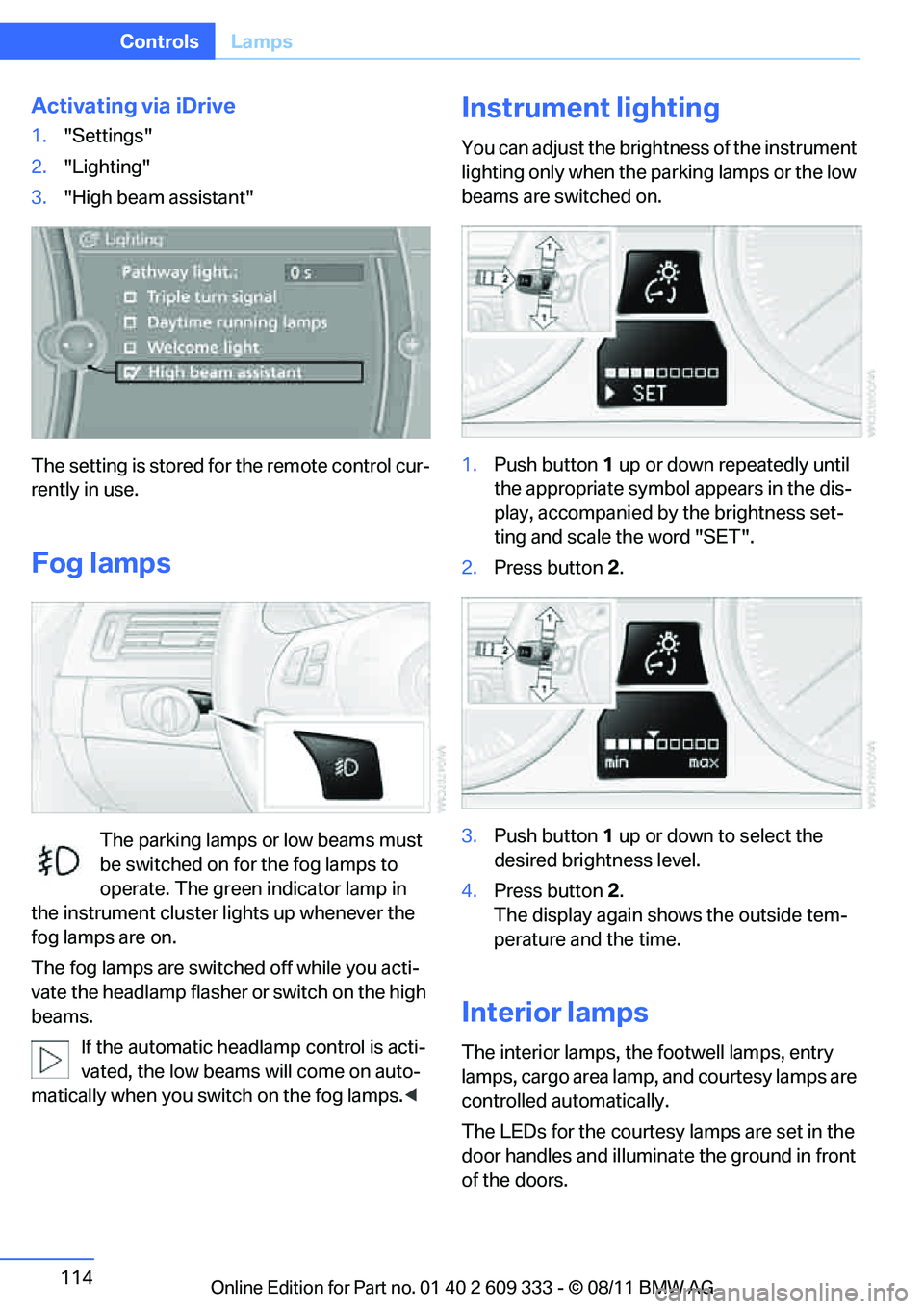
114
ControlsLamps
Activating via iDrive
1."Settings"
2. "Lighting"
3. "High beam assistant"
The setting is stored for the remote control cur-
rently in use.
Fog lamps
The parking lamps or low beams must
be switched on for the fog lamps to
operate. The green indicator lamp in
the instrument cluster lights up whenever the
fog lamps are on.
The fog lamps are switched off while you acti-
vate the headlamp flasher or switch on the high
beams.
If the automatic headla mp control is acti-
vated, the low beams will come on auto-
matically when you swit ch on the fog lamps.<
Instrument lighting
You can adjust the brightness of the instrument
lighting only when the pa rking lamps or the low
beams are switched on.
1. Push button 1 up or down repeatedly until
the appropriate symbol appears in the dis-
play, accompanied by the brightness set-
ting and scale the word "SET".
2. Press button 2.
3. Push button 1 up or down to select the
desired brightness level.
4. Press button 2.
The display again shows the outside tem-
perature and the time.
Interior lamps
The interior lamps, the footwell lamps, entry
lamps, cargo area lamp, and courtesy lamps are
controlled automatically.
The LEDs for the courtesy lamps are set in the
door handles and illuminate the ground in front
of the doors.
Online Edition for Part no. 01 40 2 609 333 - \251 08/11 BMW AG
Page 280 of 314
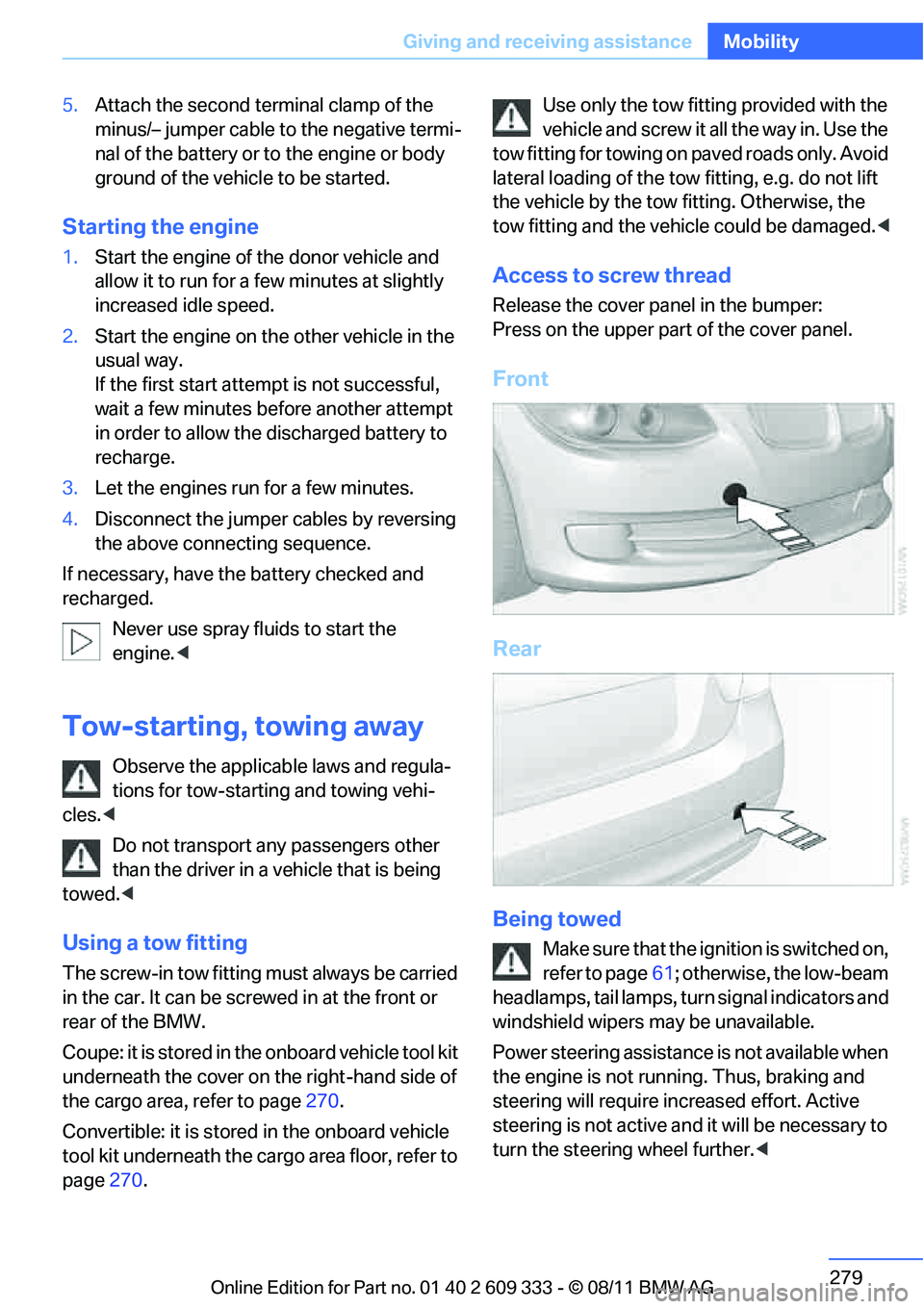
279
Giving and receiving assistance
Mobility
5.
Attach the second te rminal clamp of the
minus/– jumper cable to the negative termi-
nal of the battery or to the engine or body
ground of the vehicle to be started.
Starting the engine
1. Start the engine of the donor vehicle and
allow it to run for a fe w minutes at slightly
increased idle speed.
2. Start the engine on the other vehicle in the
usual way.
If the first start attempt is not successful,
wait a few minutes be fore another attempt
in order to allow the discharged battery to
recharge.
3. Let the engines run for a few minutes.
4. Disconnect the jumper cables by reversing
the above connecting sequence.
If necessary, have th e battery checked and
recharged.
Never use spray fluids to start the
engine. <
Tow-starting, towing away
Observe the applicable laws and regula-
tions for tow-starting and towing vehi-
cles. <
Do not transport any passengers other
than the driver in a vehicle that is being
towed. <
Using a tow fitting
The screw-in tow fitting must always be carried
in the car. It can be sc rewed in at the front or
rear of the BMW.
Coupe: it is stored in the onboard vehicle tool kit
underneath the cover on the right-hand side of
the cargo area, refer to page 270.
Convertible: it is stored in the onboard vehicle
tool kit underneath the ca rgo area floor, refer to
page 270. Use only the tow fitting provided with the
vehicle and screw it all the way in. Use the
tow fitting for towing on paved roads only. Avoid
lateral loading of the tow fitting, e.g. do not lift
the vehicle by the tow fitting. Otherwise, the
tow fitting and the vehicle could be damaged. <
Access to screw thread
Release the cover panel in the bumper:
Press on the upper part of the cover panel.
Front
Rear
Being towed
Make sure that the ignition is switched on,
refer to page61; otherwise, the low-beam
headlamps, tail lamps, turn signal indicators and
windshield wipers may be unavailable.
Power steering assistance is not available when
the engine is not running. Thus, braking and
steering will require in creased effort. Active
steering is not active an d it will be necessary to
turn the steering wheel further. <
Online Edition for Part no. 01 40 2 609 333 - \251 08/11 BMW AG
Page 299 of 314

298
ReferenceEverything from A to Z
Everything from A to Z
Index
A
ABS Antilock Brake
System 97
ACC, refer to Active Cruise Control 75
Acceleration assistant, refer to Launch Control 70
Accessories, refer to Vehicle
equipment 5
Accident, refer to Sending an Emergency Request 276
Activated-charcoal filter for automatic climate
control 120
Active Cruise Control 75
– indicator lamp 78
– malfunction 79
– selecting distance 77
– sensor 78
Active steering 105
Adaptive brake lamp
– Brake Force Display 106
Adaptive Light Control 112
Additives
– coolant 263
– engine oil 262
Address, entering 150,156
Address for navigation
– entering 150
Adjusting temperature inside the car, refer to Automatic
climate control 117
Adjusting the thigh support 49
Airbags 107
– indicator/warning lamp 108
– sitting safely 47
Air conditioning mode
– automatic climate control 117
– ventilation 119 Air distribution
– automatic
118
Airing, refer to Ventilation 119
Air pressure, refer to Tire inflation pressure 239
Air recirculation, refer to
Recirculated air mode 118
Air supply
– automatic climate
control 117
– ventilation 119
Air vents 116
Air volume 118
AKI, refer to Fuel grade 237
Alarm system 37
– avoiding unintentional alarms 38
– interior motion sensor 38
– switching off an alarm 37
– tilt alarm sensor 37
ALL program 119
All-season tires, refer to Winter tires 258
All-wheel drive, refer to xDrive 99
Ambient
air, refer to
Recirculated air mode 118
Antifreeze
– coolant 263
– washer fluid 72
Antilock Brake System ABS 97
Anti-theft alarm system, refer to Alarm system 37
Appointments, refer to
Calendar 223
Approved axle loads, refer to Weights 287
Approved engine oils 262
Approved gross vehicle weight, refer to Weights 287Apps
232
Armrest, refer to Center armrest 126
Arrival time, refer to Computer 84
Ashtray 128
Assist systems, refer to Driving stability control 97
AUC Automatic recirculated
air control 118
Audible instructions, refer to Voice instructions 161
Audio device, external 127
Automatic
– air distribution 118
– air volume 118
– cruise control 73,75
– headlamp control 110
Automatic car washes 266
Automatic climate control 116
Automatic curb monitor 55
Automatic high beams and low beams, refer to High-
beam Assistant 113
Automatic recirculated air control AUC 118
Automatic Service Request 232
Automatic transmission with
Steptronic 64
– interlock 64
– overriding selector lever
lock 66
– shiftlock, refer to Changing selector lever position 64
– sport program 65
– towing 279
– tow-starting 279
AUTO program for automatic climate control 118
Online Edition for Part no. 01 40 2 609 333 - \251 08/11 BMW AG
Page 303 of 314

302
ReferenceEverything from A to Z
Displays
– on the Control Display 18
Displays, refer to Instrument cluster 12
Displays and controls 10
Disposal
– coolant 263
– remote control battery 40
– vehicle battery 275
Distance remaining to service, refer to Service
requirements 87
Distance warning, refer to Park Distance Control
PDC 96
Door key, refer to Remote
control with integrated
key 30
Door lock 34
Doors, emergency operation 34
DOT Quality Grades 255
Draft-free ventilation 120
Drinks holders, refer to Cupholders 128
Drive mode 68
Drive-off assistance, refer to Dynamic Stability Control
DSC 97
Drive-off assistant 100
Driving dynamics control 69
Driving lamps, refer to Parking lamps/low beams 110
Driving notes 138
Driving off on hills, refer to Drive-off assistant 100
Driving stability control
systems 97
Driving through water 140
Driving tips, refer to Driving
notes 138
Dry air, refer to Cooling function 119 DSC Dynamic Stability
Control 97
DTC Dynamic Traction Control 98
– indicator/warning lamp 98
Dynamic Brake Control DBC 97
Dynamic destination
guidance 166
Dynamic Stability Control DSC 97
– indicator/warning lamp 98
E
EBV Electronic brake-force
distribution 97
Electrical defect
– 7-gear Sport automatic
transmission with double
clutch 69
Electrical malfunction
– door lock 34
– driver's door 34
– fuel filler flap 236
– glass roof 42
Electric seat adjustment 49
Electric steering wheel lock
– with Comfort Access 39
Electronic brake-force distribution EBV 97
Electronic oil level check 260
Electronic Stability Program ESP, refer to Dynamic
Stability Control DSC 97
E-mail 222
Emergency actuation,
automatic transmission,
refer to Overriding selector
lever lock 66
Emergency operation
– fuel filler flap, manual release 236 Emergency operation, refer to
Closing manually
– glass roof 42
Emergency operation, refer to Manual operation
– door lock 34
Emergency release
– trunk lid from inside 36
Emergency Request 276
Emergency services, refer to Roadside Assistance 277
Energy, saving
– saving fuel 138
Engine
– breaking in 138
– data 284
– overheated, refer to Coolant temperature 263
– speed 284
– starting 62
– starting, Comfort Access 38
– switching off 63
Engine compartment 259
Engine coolant, refer to Coolant 263
Engine oil
– adding 262
– additives, refer to Approved
engine oils 262
– alternative oil types 263
– approved engine oils 262
– BMW Maintenance System 264
– capacity 289
– checking level 260
– intervals between changes, refer to Service
requirements 87
Engine output, refer to Engine data 284
Engine speed, ref
er to Engine
data 284
Engine starting, refer to
Starting the engine 62
Online Edition for Part no. 01 40 2 609 333 - \251 08/11 BMW AG